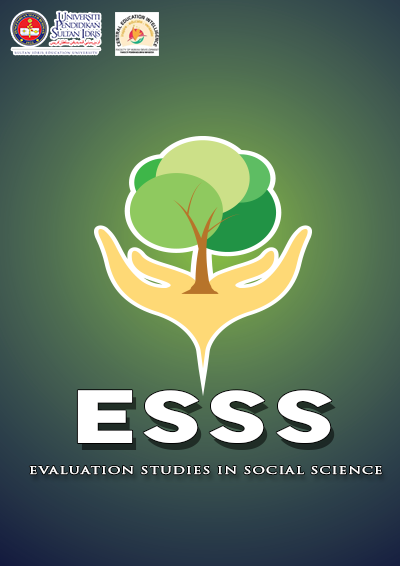Relationship between Mindfulness and Nomophobia among teaching practice students
DOI:
https://doi.org/10.37134/esss.vol3.2.1.2022Keywords:
nomophobia, mindfulness, teaching practice, educationAbstract
This study aimed to investigate the relationship between mindfulness and nomophobia among teaching practice students in UPSI. This descriptive cross-sectional quantitative survey design study utilized online survey which required participants to submit responses through Google Form link distributed. Instruments used in this study were Mindful Attention Awareness Scale (MAAS) and Nomophobia Questionnaire (NMP-Q). Data from N=142 teaching practice students (n=105 female, n=37 male) were analyzed using IBM SPSS Statistics 26. Pearson correlation between mindfulness and nomophobia showed a surprising finding, in which no correlation (r=-0.026, N=142, p > 0.05) was found between these two variables. This study has argued that no relationship was found since the sample was recruited from a leading education university in Malaysia, hence they have been trained to be a competent prospective teacher. Besides, their nature of working which require regular phone usage also was argued to be the underlying reason of this study’s finding in which higher usage of mobile phone may cause the above average score of nomophobia, but at the same time they obtained an above average score of mindfulness level as well. Hence, there is no relationship from the finding reported. This study was found to have an implication towards recruiter of future teachers, and has contributed to the literature of mindfulness and nomophobia among Malaysians.
Downloads
References
Alawamleh, M., Al-Twait, L. M., & Al-Saht, G. R. (2020). The effect of online learning on communication between instructors and students during Covid-19 pandemic. Asian Education and Development Studies, 11(2). https://doi.org/10.1108/AEDS-06-2020-0131
Arikan, E. E. (2016). Prospective Teachers’ Beliefs about Problem Solving in Multiple Ways. Universal Journal of Educational Research, 4(7), 1727-1733. https://doi.org/10.13189/ujer.2016.040727
Arpaci, I., & Gundogan, S. (2020). Mediating role of psychological resilience in the relationship between mindfulness and nomophobia. British Journal of Guidance & Counselling. https://doi.org/10.1080/03069885.2020.1856330
Arpaci, I., Baloğlu, M., & Kesici, Ş. (2017). A multi-group analysis of the effects of individual differences in mindfulness on nomophobia. Information Development, 35(2), 333-341. https://doi.org/10.1177/0266666917745350
Arpaci, I., Baloğlu, M., Özteke Kozan, H. İ., & Kesici, Ş. (2017). Individual Differences in the Relationship Between Attachment and Nomophobia Among College Students: The Mediating Role of Mindfulness. Journal of Medical Internet Research, 19(12). https://doi.org/10.2196/jmir.8847
Bhattacharya, S., Bashar, M. A., Srivasta, A., & Singh, A. (2019). NOMOPHOBIA: NO MObile PHone PhoBIA. Journal of Family Medicine and Primary Care, 8(4), 1297-1300. https://doi.org/10.4103/jfmpc.jfmpc_71_19
Biswas, B., Roy, S. K., & Roy, F. (2020). Students Perception of Mobile Learning during COVID-19 in Bangladesh: University Student Perspective. Aquademia, 4(2), ep20023. https://doi.org/10.29333/aquademia/8443
Bragazzi, N. L., & Del Puente, G. (2014). A proposal for including nomophobia in the new DSM-V. Psychology Research and Behavior Management, 7, 155–160. https://doi.org/10.2147/PRBM.S41386
Brown, K. W., & Ryan, R. M. (2003). The Benefits of Being Present: Mindfulness and Its Role in Psychological Well-Being. Journal of Personality and Social Psychology, 84(4), 822-848. https://doi.org/10.1037/0022-3514.84.4.822
Eagly, A. H., & Wood, W. (2016). Social Role Theory of Sex Differences. The Wiley Blackwell Encyclopedia of Gender and Sexuality Studies, 1-3. https://doi.org/10.1002/9781118663219.wbegss183
Gezgin, D. M., Hamutoğlu, N. B., Sezen-Gültekin, G. & Yıldırım, S. (2019). Preservice Teachers’ Metaphorical Perceptions on Smartphone, No Mobile Phone Phobia (Nomophobia) and Fear of Missing Out (FoMO). Bartın University Journal of Faculty of Education, 8(2), 733-783. https://doi.org/10.14686/buefad.516540
Gezgin, D. M., Sumuer, E., Arslan, O., & Yildirim, S. (2017). Nomophobia Prevalence among Pre-service Teachers: A case of Trakya University. Trakya Üniversitesi Eğitim Fakültesi Dergisi, 7(1). Retrieved from https://dergipark.org.tr/en/pub/trkefd/issue/27304/287423
Kindel, H. R., & Rafoth, M. A. (2020). The Effects of Teaching Mindfulness on Stress in Physical Therapy Students – A Randomized Controlled Trial. Health Professions Education, 6(2), 142-152. https://doi.org/10.1016/j.hpe.2019.04.002
Malaysian Communications and Multimedia Commmission (MCMC). (2019). Hand Phone Users Survey 2018. https://www.mcmc.gov.my/en/resources/statistics/hand-phone-surveys
Samad, M. R. A., Ihsan, Z. H., & Khalid, F. (2021). The Use of Mobile Learning in Teaching and Learning Session during the Covid-19 Pandemic in Malaysia. Journal of Contemporary Social Science and Educational Studies, 1(2), 46-65. Retrieved from http://jocss.com/index.php/multidiscipline/article/view/52
Sevim-Cirak, N., & Islim, O. F. (2020). Investigation into Nomophobia amongst Turkish pre-service teachers. Education and Information Technologies, 26, 1877-1895. https://doi.org/10.1007/s10639-020-10335-9
Yildirim, C., & Correia, A.-P. (2015). Exploring the dimensions of nomophobia: Development and validation of a self-reported questionnaire. Computers in Human Behavior, 49, 130-137. https://doi.org/10.1016/j.chb.2015.02.059
Yildirim, C., Sumuer, E., Adnan, M., & Yildirim, S. (2016). A growing fear: Prevalence of nomophobia among Turkish college students. Information Development, 32(5), 1322-1331. https://doi.org/10.1177/0266666915599025
Zainal, N. Z., Nor-Aziyan, Y., & Subramaniam, P. (2015). Psychometric Properties of the Malay-Translated Mindfulness, Attention and Awareness Scale (MAAS) in A Group of Nursing Students in Malaysia. Malaysian Journal of Psychiatry, 24(1).
Downloads
Published
How to Cite
Issue
Section
License
Copyright (c) 2022 Muhd Fadlin Muhammad Firdaus Chan, Nurul Ain Hidayah Abas

This work is licensed under a Creative Commons Attribution-NonCommercial-ShareAlike 4.0 International License.





